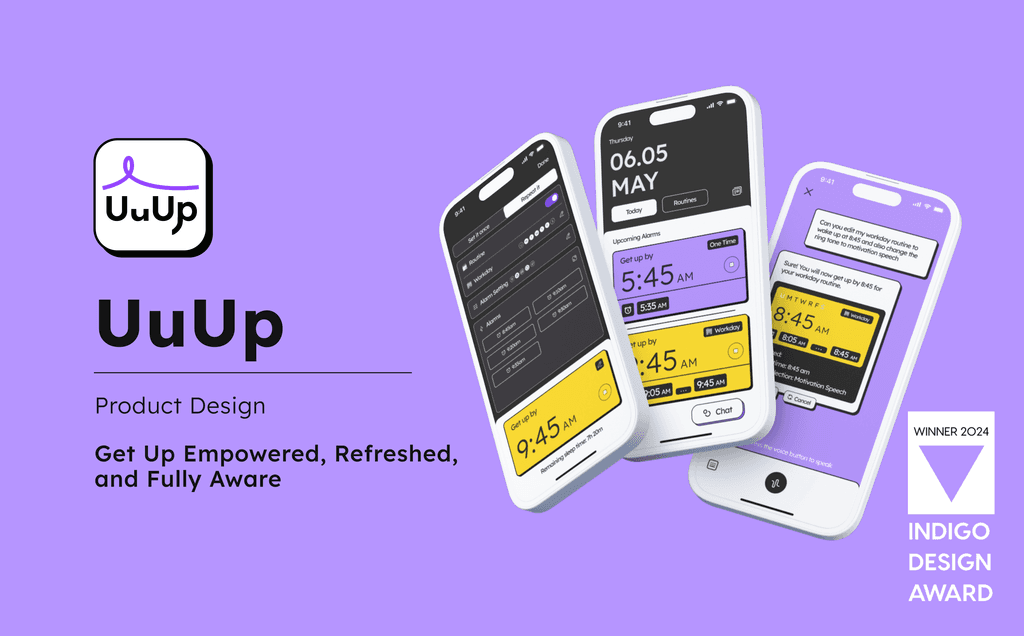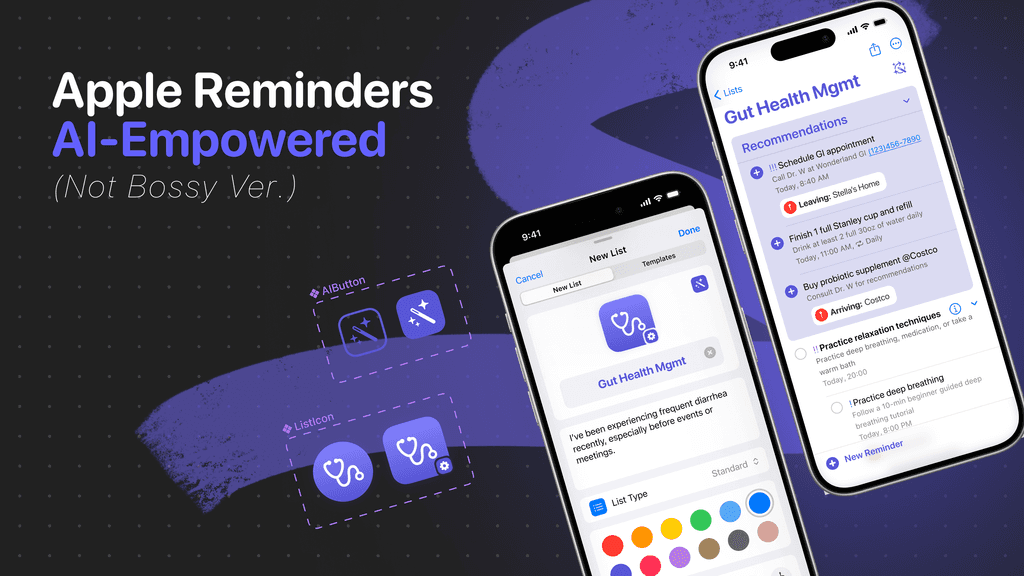Realms
Helping Local Business Regain Customer Engagement during COVID-19
Realms is a community-based social media platform aiming to help local business regain customer engagement.
Helping Local Business Regain Customer Engagement during COVID-19
Realms is a community-based social media platform aiming to help local business regain customer engagement.
Helping Local Business Regain Customer Engagement during COVID-19
Realms is a community-based social media platform aiming to help local business regain customer engagement.
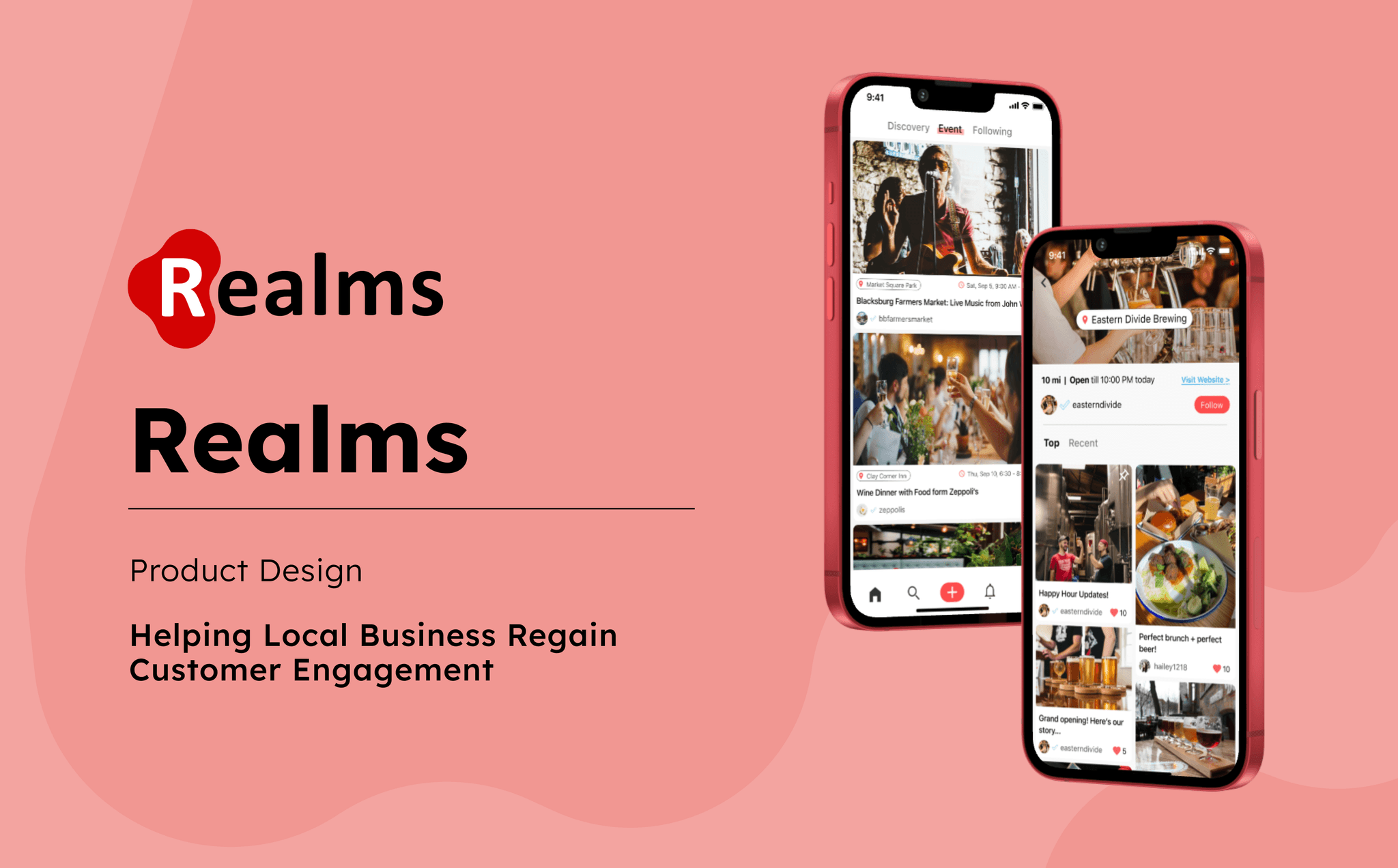


THE PROBLEM
Small businesses constitute more than 99 percent of US businesses. They are crucial to the US economy, and the COVID-19 crisis has deeply affected them: 43% of businesses were temporarily closed during the pandemic by April 2020.
The Realms project was started by two of my friends in Virginia Tech. As VT students, we had been living in Blacksburg for over 4 years. It is a small and beautiful town, and the team had a simple mission: to provide support for local small businesses, especially during COVID.
I then proposed to be onboarded because I share the same passion, but more importantly, I felt the idea needed some additional point of view and design thinking.
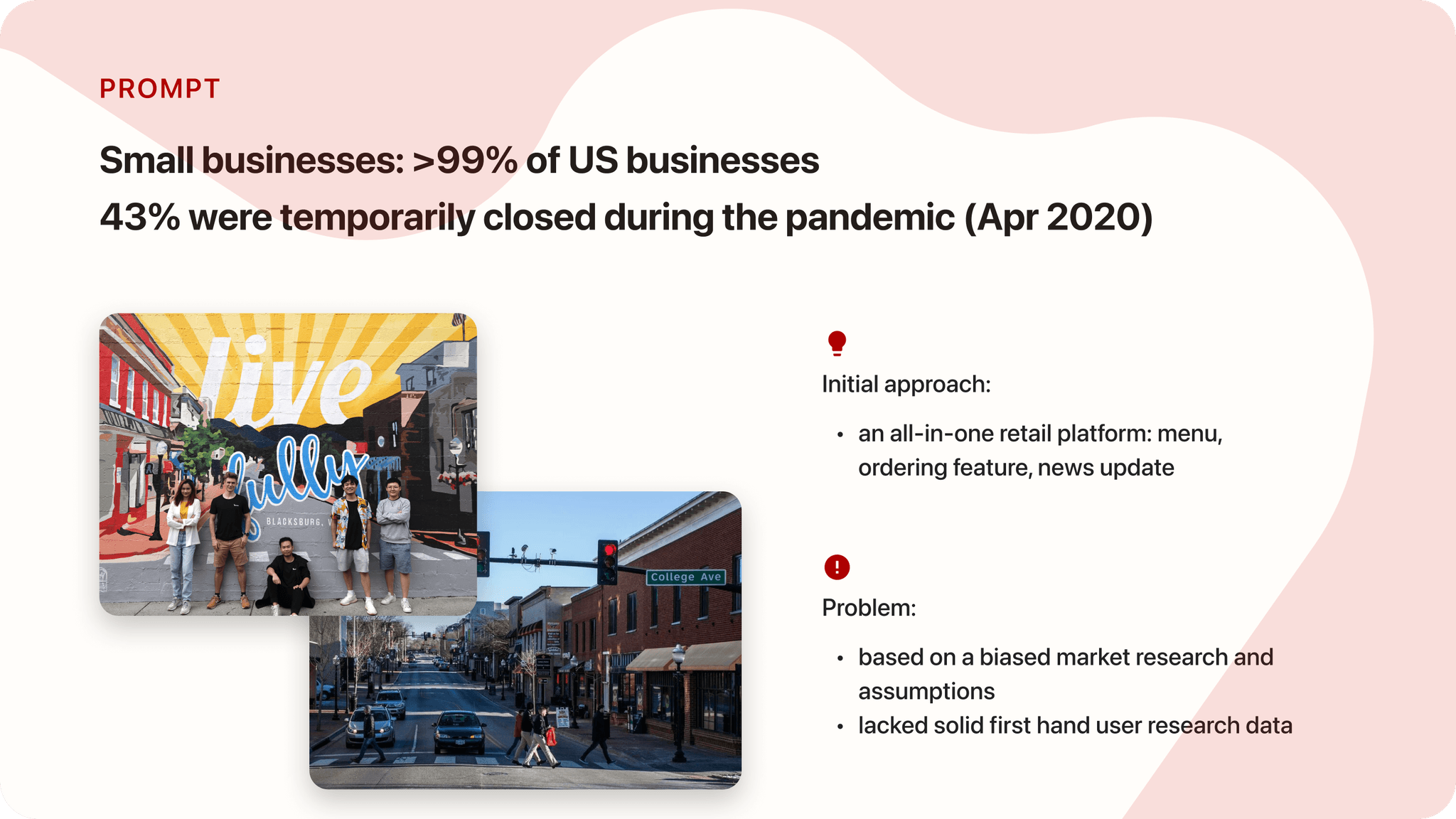
The team initially wanted to create an all-in-one platform that includes menus, ordering features, shop news updates, and everything that’s related to a small business. I soon realized that it lacked solid first-hand user research data from both business owners and customers, which I believed would bring underlying uncertainties and risks to the product in the long run.
I drafted a research plan and convinced the team about the importance of user research and empathetical thinking. The team agreed with me to do more research.
THE PROBLEM
Small businesses constitute more than 99 percent of US businesses. They are crucial to the US economy, and the COVID-19 crisis has deeply affected them: 43% of businesses were temporarily closed during the pandemic by April 2020.
The Realms project was started by two of my friends in Virginia Tech. As VT students, we had been living in Blacksburg for over 4 years. It is a small and beautiful town, and the team had a simple mission: to provide support for local small businesses, especially during COVID.
I then proposed to be onboarded because I share the same passion, but more importantly, I felt the idea needed some additional point of view and design thinking.

The team initially wanted to create an all-in-one platform that includes menus, ordering features, shop news updates, and everything that’s related to a small business. I soon realized that it lacked solid first-hand user research data from both business owners and customers, which I believed would bring underlying uncertainties and risks to the product in the long run.
I drafted a research plan and convinced the team about the importance of user research and empathetical thinking. The team agreed with me to do more research.
THE PROBLEM
Small businesses constitute more than 99 percent of US businesses. They are crucial to the US economy, and the COVID-19 crisis has deeply affected them: 43% of businesses were temporarily closed during the pandemic by April 2020.
The Realms project was started by two of my friends in Virginia Tech. As VT students, we had been living in Blacksburg for over 4 years. It is a small and beautiful town, and the team had a simple mission: to provide support for local small businesses, especially during COVID.
I then proposed to be onboarded because I share the same passion, but more importantly, I felt the idea needed some additional point of view and design thinking.

The team initially wanted to create an all-in-one platform that includes menus, ordering features, shop news updates, and everything that’s related to a small business. I soon realized that it lacked solid first-hand user research data from both business owners and customers, which I believed would bring underlying uncertainties and risks to the product in the long run.
I drafted a research plan and convinced the team about the importance of user research and empathetical thinking. The team agreed with me to do more research.
Research
01 . BASELINE STUDY
First, I did the baseline study by talking to the business owners to understand their situation and explore how we can help them, and I found some interesting insights.
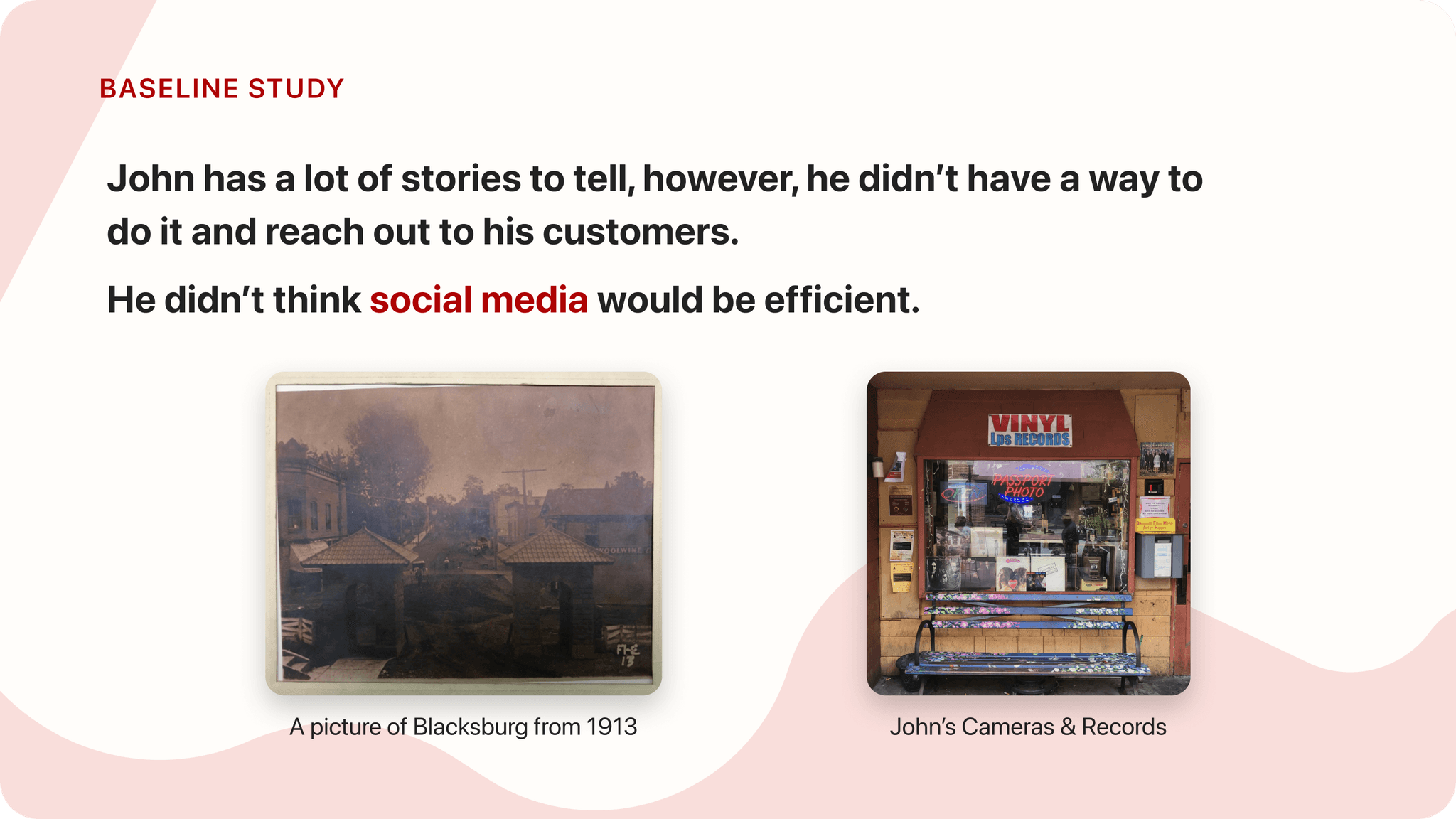
This is a picture from 1913, by that time Virginia Tech had a gate on college avenue which is not there anymore. This was told by the owner of John’s Cameras & Records, a local retail in Blacksburg.
This is one of his collections of Blacksburg history as he owns the store for the past 30 years. His memory about Blacksburg and his passion for photography could have been the perfect story and advertisement for his business, but he didn’t have a way to tell them: He barely posts anything on social media, and he didn’t think Facebook or Instagram was efficient to help his business or reach out to customers.
02. USER RESEARCH
That was NOT the only time I heard a complaint like this. I decided to do more research to explore this valuable idea. By analyzing the research data, I formed 6 insights from business owners and 6 from customers.
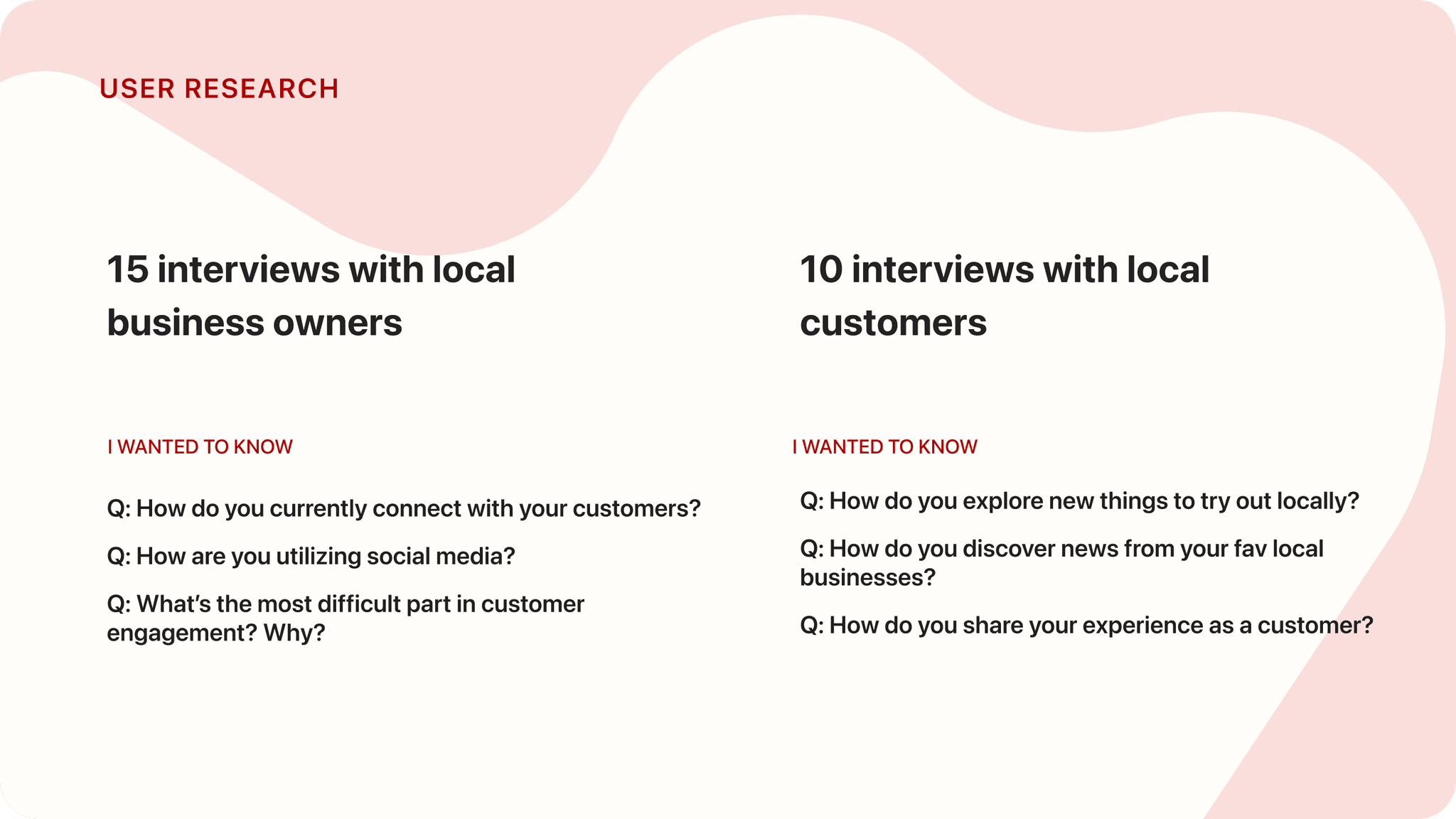
For business owners
Some of them have a presence on social media, but they are competing with a large portion of friends and family and other main content on FB and Instagram. They are trying hard to do it but feel like their posts can only get discovered by luck and are not worth the effort.
They also think short reviews and ratings cannot represent them and their businesses. Although they want to use them to tell a good story to get recognized more, all the info is scattered on different platforms.
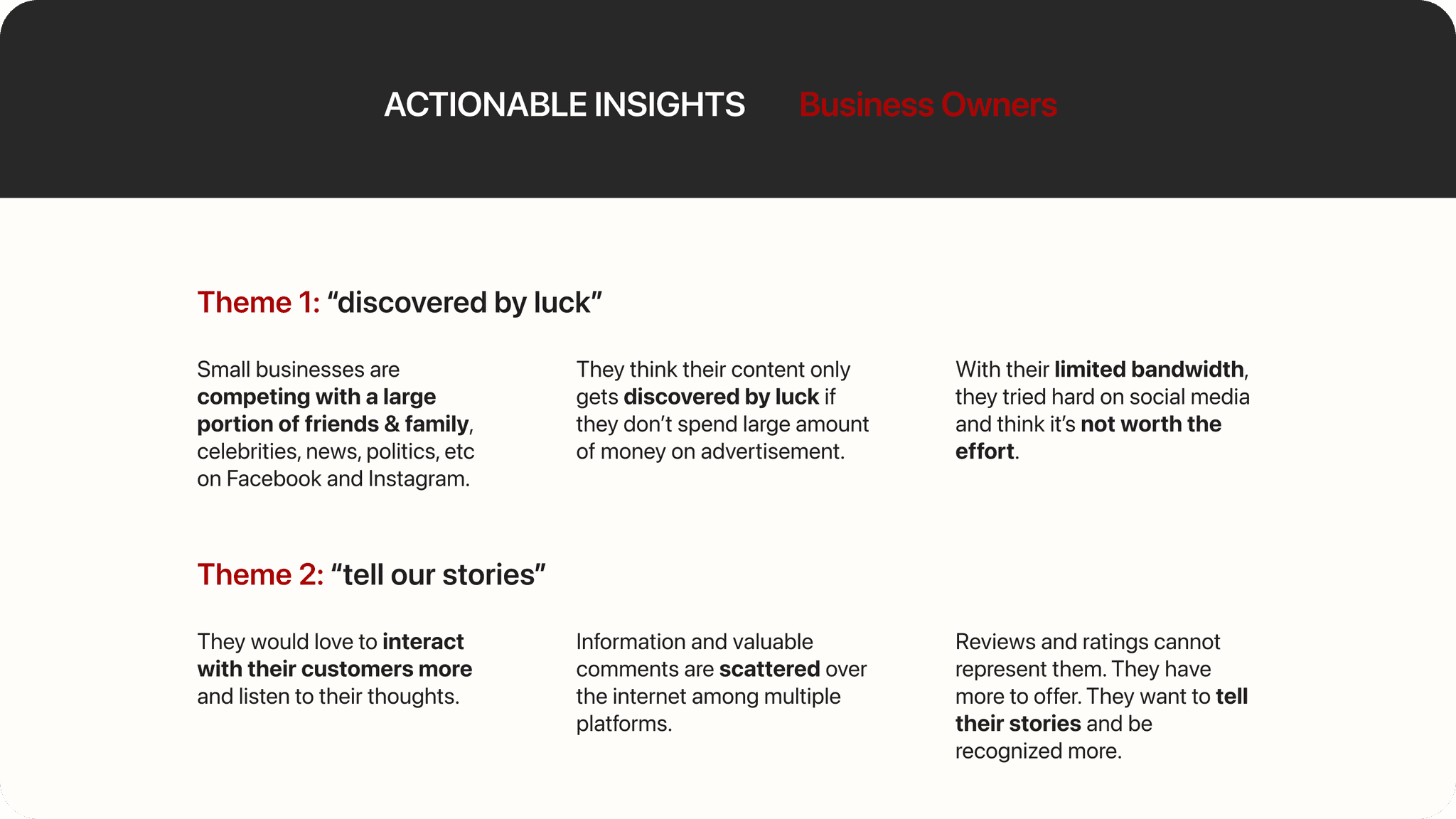
For customers
They are having a hard time discovering new things to try out. Word of mouth is the most important channel that encourages them to explore.
Also, they’d like to share their experience and help their favorite businesses grow, but don’t want to post all the time on their personal accounts and maybe their friends won’t like to see those posts all the time.
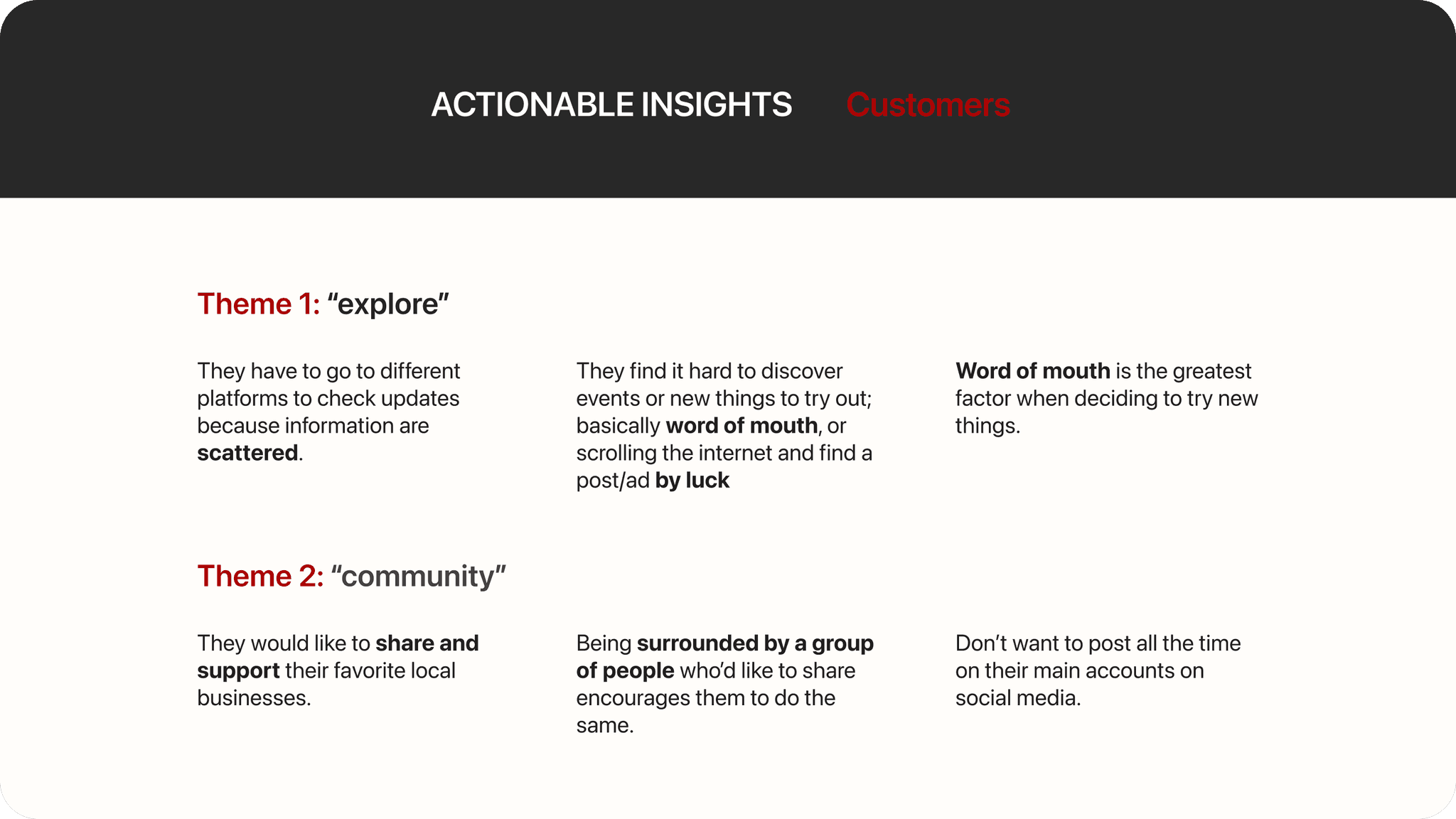
The Pivot
Our research revealed the right problem to solve:
With all the existing delivery and ordering platforms, what small businesses really care about is how to effectively communicate and maintain the relationship with their customers.
I proposed a pivot, that instead of doing an all-in-one platform, we should narrow the focus on maintaining customer engagement.
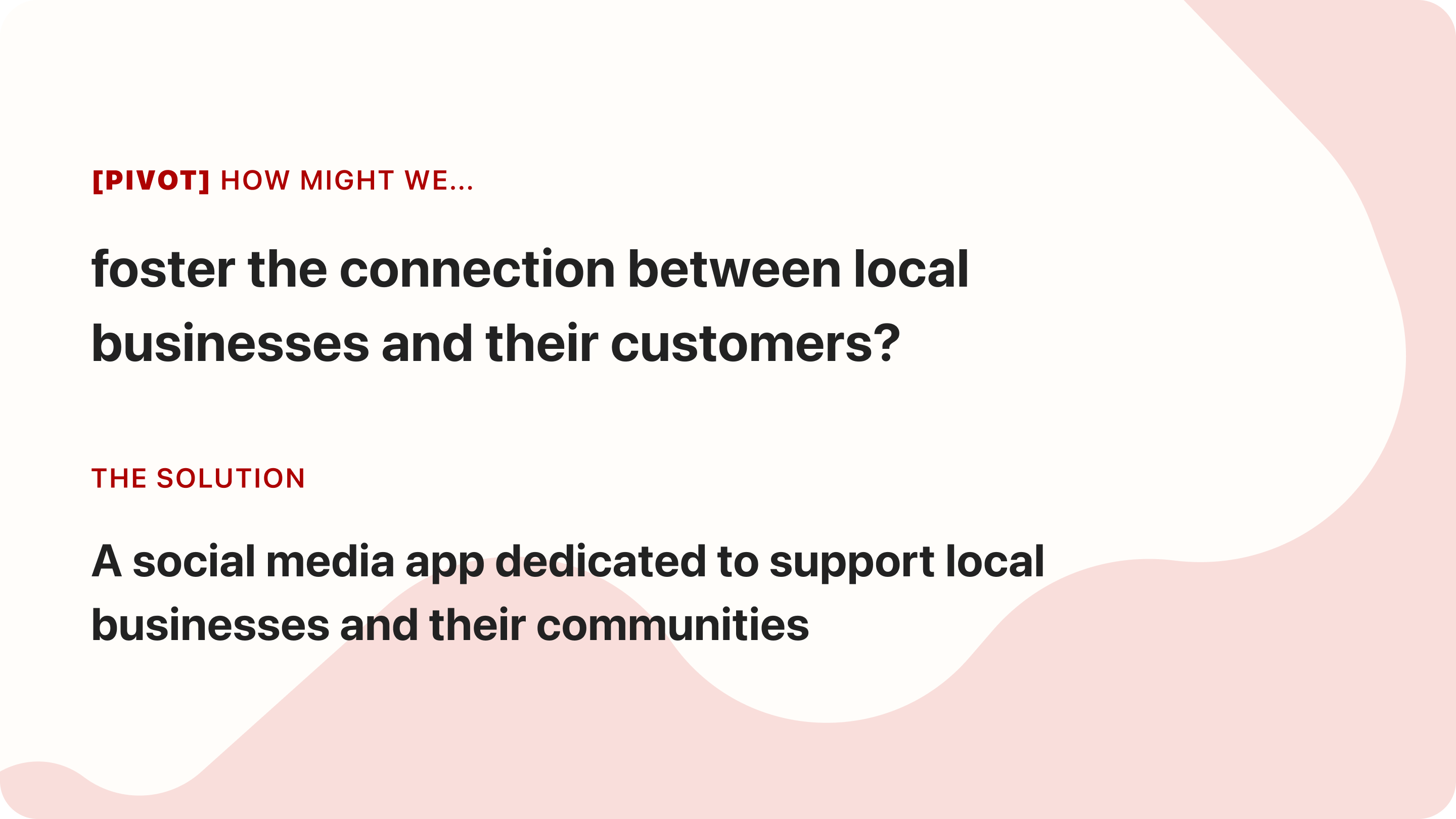
We’d like to tell stories, from both business owners and customers.
We’d like to create a platform where they can hear each other, by building their own communities, their own realms.
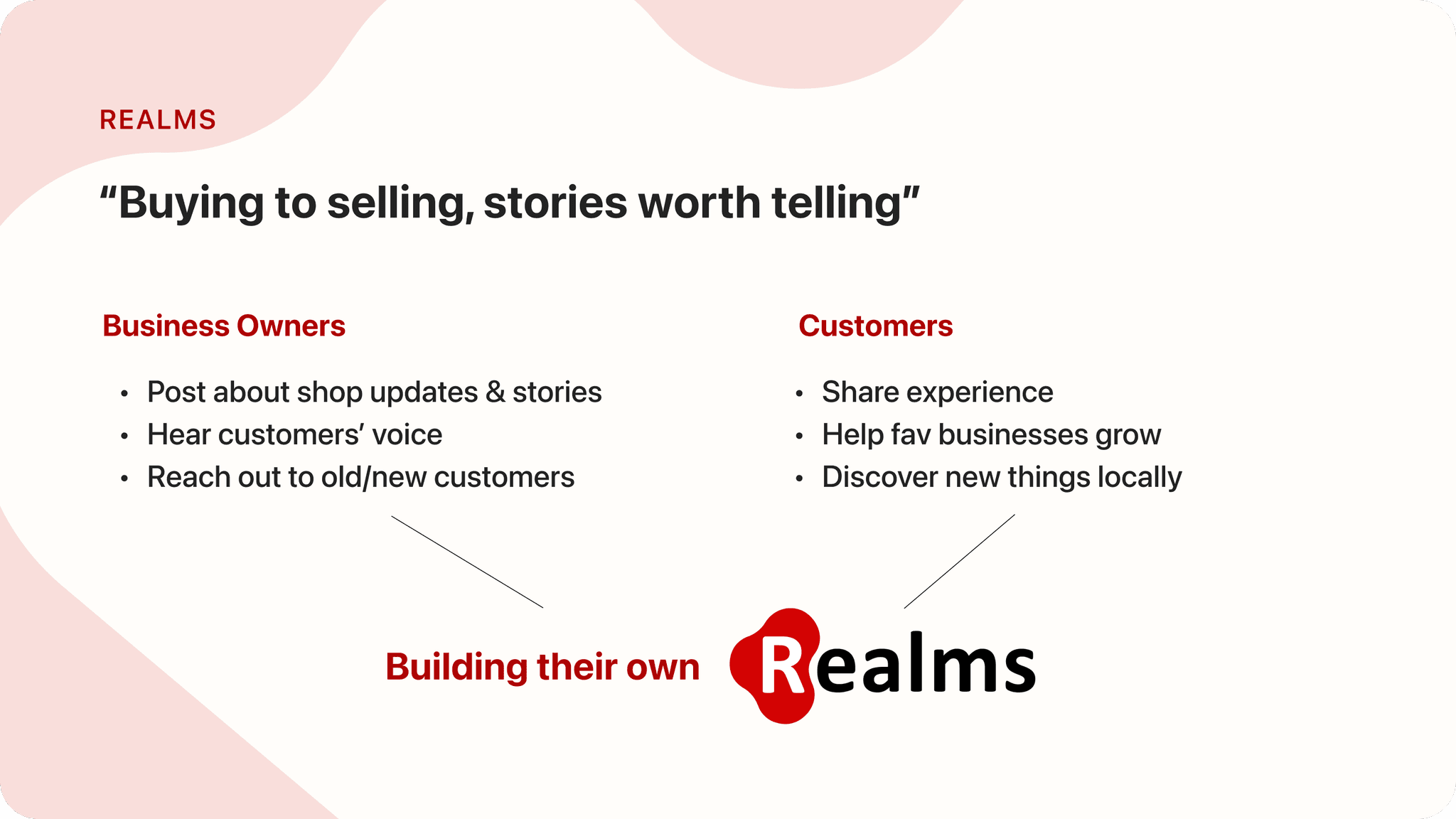
For customers
They are having a hard time discovering new things to try out. Word of mouth is the most important channel that encourages them to explore.
Also, they’d like to share their experience and help their favorite businesses grow, but don’t want to post all the time on their personal accounts and maybe their friends won’t like to see those posts all the time.

THE SOLUTION
01 . Discovery Page & Interface Layout
I did design iterations based on several rounds of testing, one of the major design decisions is the page layout.
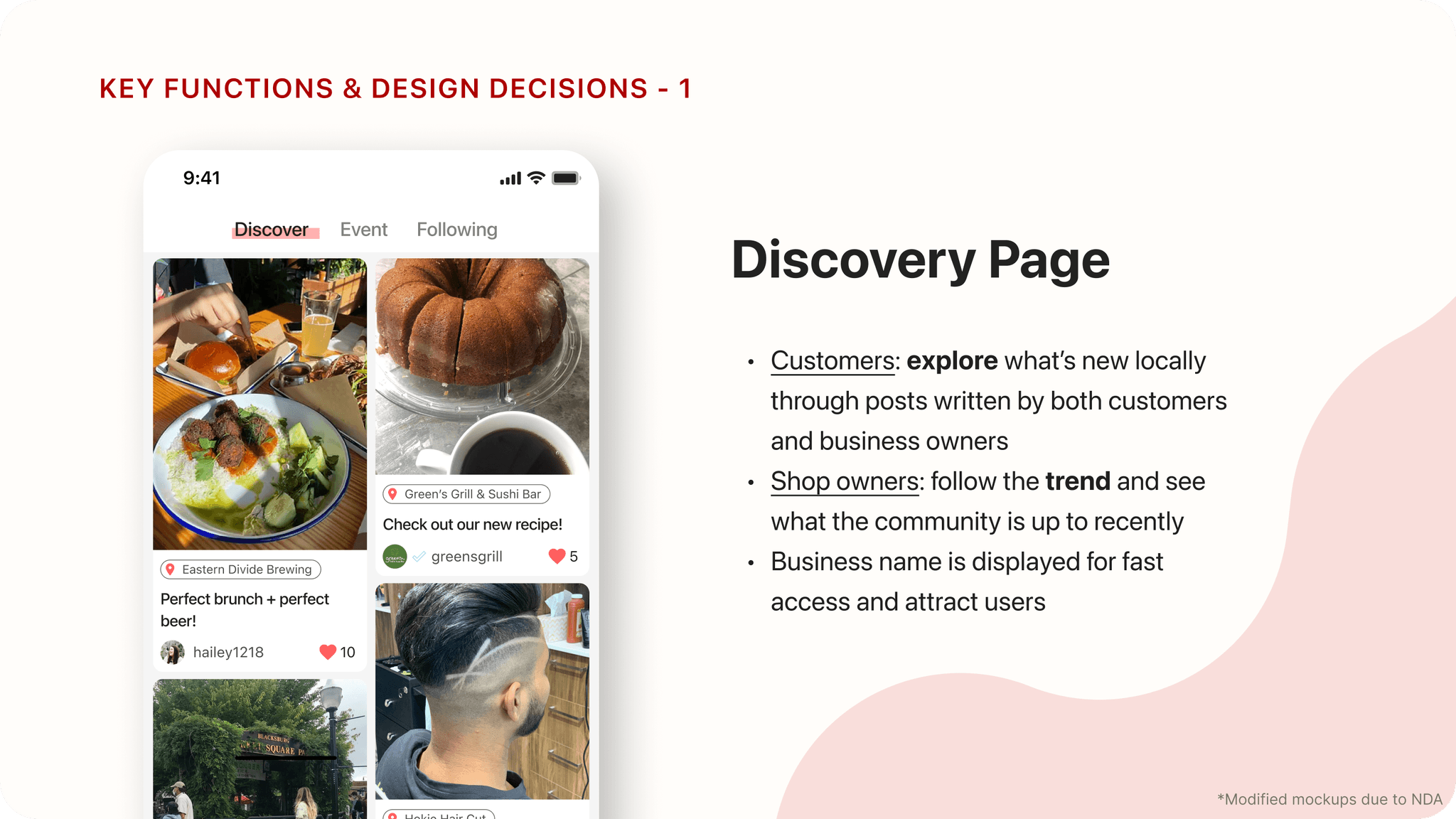
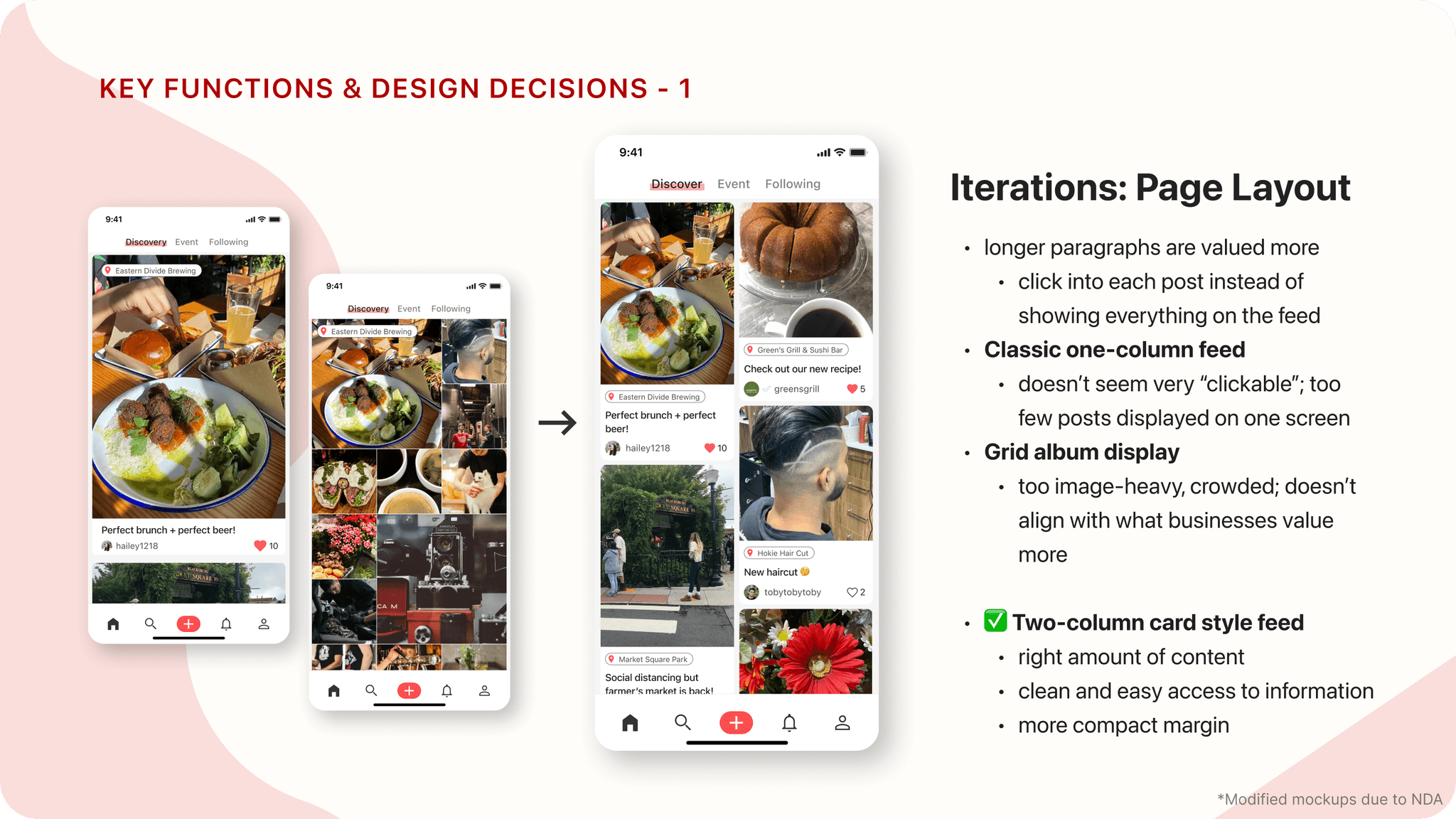
02. Post Page
After clicking on the card on the discovery page, the full post details are displayed.

03. Event Discovery
The third key function is the event page. It’s another tab just like discovery in the homepage, where the users can easily access all time-sensitive information.
Originally it used the same two-column feed layout just like the discovery page, and then I modified it by listening to the feedback.

04. The Realm - Business's Community
After clicking the business title tag, users will be led here to a page that’s dedicated to this business - its Realm page. All posts related to the business will be displayed here, but instead of a simple hashtag system, I added features that can actually help bond the relationship between businesses and their customers.
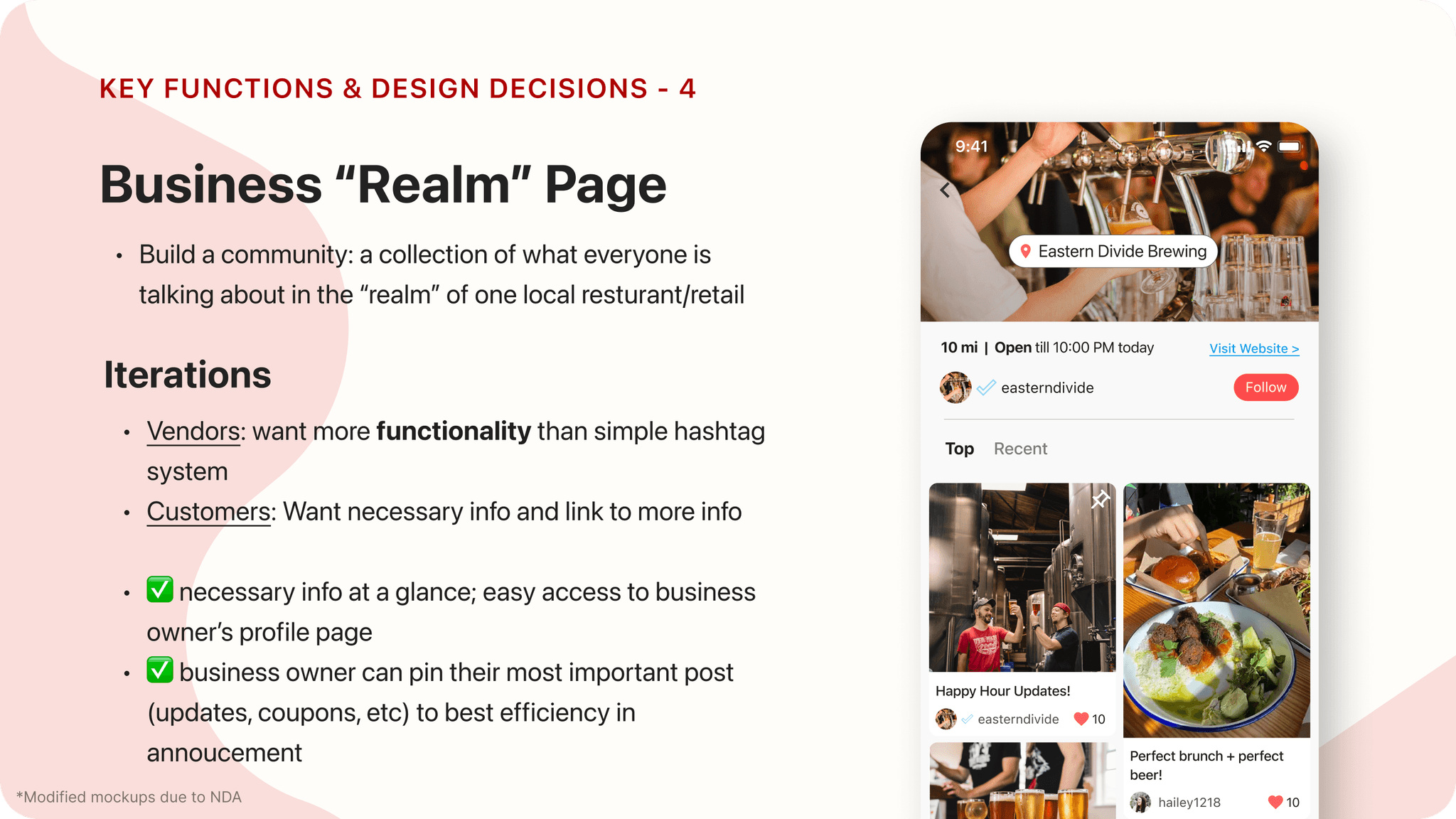
Research
01 . BASELINE STUDY
First, I did the baseline study by talking to the business owners to understand their situation and explore how we can help them, and I found some interesting insights.

This is a picture from 1913, by that time Virginia Tech had a gate on college avenue which is not there anymore. This was told by the owner of John’s Cameras & Records, a local retail in Blacksburg.
This is one of his collections of Blacksburg history as he owns the store for the past 30 years. His memory about Blacksburg and his passion for photography could have been the perfect story and advertisement for his business, but he didn’t have a way to tell them: He barely posts anything on social media, and he didn’t think Facebook or Instagram was efficient to help his business or reach out to customers.
02. USER RESEARCH
That was NOT the only time I heard a complaint like this. I decided to do more research to explore this valuable idea. By analyzing the research data, I formed 6 insights from business owners and 6 from customers.

For business owners
Some of them have a presence on social media, but they are competing with a large portion of friends and family and other main content on FB and Instagram. They are trying hard to do it but feel like their posts can only get discovered by luck and are not worth the effort.
They also think short reviews and ratings cannot represent them and their businesses. Although they want to use them to tell a good story to get recognized more, all the info is scattered on different platforms.

For customers
They are having a hard time discovering new things to try out. Word of mouth is the most important channel that encourages them to explore.
Also, they’d like to share their experience and help their favorite businesses grow, but don’t want to post all the time on their personal accounts and maybe their friends won’t like to see those posts all the time.

The Pivot
Our research revealed the right problem to solve:
With all the existing delivery and ordering platforms, what small businesses really care about is how to effectively communicate and maintain the relationship with their customers.
I proposed a pivot, that instead of doing an all-in-one platform, we should narrow the focus on maintaining customer engagement.

We’d like to tell stories, from both business owners and customers.
We’d like to create a platform where they can hear each other, by building their own communities, their own realms.

For customers
They are having a hard time discovering new things to try out. Word of mouth is the most important channel that encourages them to explore.
Also, they’d like to share their experience and help their favorite businesses grow, but don’t want to post all the time on their personal accounts and maybe their friends won’t like to see those posts all the time.

THE SOLUTION
01 . Discovery Page & Interface Layout
I did design iterations based on several rounds of testing, one of the major design decisions is the page layout.


02. Post Page
After clicking on the card on the discovery page, the full post details are displayed.

03. Event Discovery
The third key function is the event page. It’s another tab just like discovery in the homepage, where the users can easily access all time-sensitive information.
Originally it used the same two-column feed layout just like the discovery page, and then I modified it by listening to the feedback.

04. The Realm - Business's Community
After clicking the business title tag, users will be led here to a page that’s dedicated to this business - its Realm page. All posts related to the business will be displayed here, but instead of a simple hashtag system, I added features that can actually help bond the relationship between businesses and their customers.

Research
01 . BASELINE STUDY
First, I did the baseline study by talking to the business owners to understand their situation and explore how we can help them, and I found some interesting insights.

This is a picture from 1913, by that time Virginia Tech had a gate on college avenue which is not there anymore. This was told by the owner of John’s Cameras & Records, a local retail in Blacksburg.
This is one of his collections of Blacksburg history as he owns the store for the past 30 years. His memory about Blacksburg and his passion for photography could have been the perfect story and advertisement for his business, but he didn’t have a way to tell them: He barely posts anything on social media, and he didn’t think Facebook or Instagram was efficient to help his business or reach out to customers.
02. USER RESEARCH
That was NOT the only time I heard a complaint like this. I decided to do more research to explore this valuable idea. By analyzing the research data, I formed 6 insights from business owners and 6 from customers.

For business owners
Some of them have a presence on social media, but they are competing with a large portion of friends and family and other main content on FB and Instagram. They are trying hard to do it but feel like their posts can only get discovered by luck and are not worth the effort.
They also think short reviews and ratings cannot represent them and their businesses. Although they want to use them to tell a good story to get recognized more, all the info is scattered on different platforms.

For customers
They are having a hard time discovering new things to try out. Word of mouth is the most important channel that encourages them to explore.
Also, they’d like to share their experience and help their favorite businesses grow, but don’t want to post all the time on their personal accounts and maybe their friends won’t like to see those posts all the time.

The Pivot
Our research revealed the right problem to solve:
With all the existing delivery and ordering platforms, what small businesses really care about is how to effectively communicate and maintain the relationship with their customers.
I proposed a pivot, that instead of doing an all-in-one platform, we should narrow the focus on maintaining customer engagement.

We’d like to tell stories, from both business owners and customers.
We’d like to create a platform where they can hear each other, by building their own communities, their own realms.

For customers
They are having a hard time discovering new things to try out. Word of mouth is the most important channel that encourages them to explore.
Also, they’d like to share their experience and help their favorite businesses grow, but don’t want to post all the time on their personal accounts and maybe their friends won’t like to see those posts all the time.

THE SOLUTION
01 . Discovery Page & Interface Layout
I did design iterations based on several rounds of testing, one of the major design decisions is the page layout.


02. Post Page
After clicking on the card on the discovery page, the full post details are displayed.

03. Event Discovery
The third key function is the event page. It’s another tab just like discovery in the homepage, where the users can easily access all time-sensitive information.
Originally it used the same two-column feed layout just like the discovery page, and then I modified it by listening to the feedback.

04. The Realm - Business's Community
After clicking the business title tag, users will be led here to a page that’s dedicated to this business - its Realm page. All posts related to the business will be displayed here, but instead of a simple hashtag system, I added features that can actually help bond the relationship between businesses and their customers.

BETA LAUNCH (📍BLACKSBURG) & IMPACT

As a designer, nothing is more exciting than seeing all the positive feedback from the business owners and the customer when we beta launch our MVP locally.
Here are some posts posted by the users, and we’re very glad that we help socially connect the vendors and their customers by building a dedicated platform for them.
We were also admitted by RAMP and 757, two regional startup accelerator programs.
Although due to funding issues, we had to put Realms to a pause. But I am very grateful that I was a part of it. It was my first startup experience.
As the only designer on the team, I am proud that I contributed to every stage of the process, found the right problem to solve, and ideated the design that was supported by the research and testing feedback.
WHAT I LEARNED
Tailor the scope and go Agile - earlier!
Although I found the right problem to solve, a social media app is quite a big scope and complex problem. There are a lot of interactions and heavily rely on the back-end and algorithm. It’s not like a passion project, I need to consider practically if it can be implemented based on our situation. Through back-and-forth communication with our development lead, we decided to learn to go agile. But I think if we tailor our scope by setting priorities, putting constraints upfront, and also going agile earlier, it will be much more smooth.
More research on different demographic when scaling
Explore more possibilities and features
BETA LAUNCH (📍BLACKSBURG) & IMPACT

As a designer, nothing is more exciting than seeing all the positive feedback from the business owners and the customer when we beta launch our MVP locally.
Here are some posts posted by the users, and we’re very glad that we help socially connect the vendors and their customers by building a dedicated platform for them.
We were also admitted by RAMP and 757, two regional startup accelerator programs.
Although due to funding issues, we had to put Realms to a pause. But I am very grateful that I was a part of it. It was my first startup experience.
As the only designer on the team, I am proud that I contributed to every stage of the process, found the right problem to solve, and ideated the design that was supported by the research and testing feedback.
WHAT I LEARNED
Tailor the scope and go Agile - earlier!
Although I found the right problem to solve, a social media app is quite a big scope and complex problem. There are a lot of interactions and heavily rely on the back-end and algorithm. It’s not like a passion project, I need to consider practically if it can be implemented based on our situation. Through back-and-forth communication with our development lead, we decided to learn to go agile. But I think if we tailor our scope by setting priorities, putting constraints upfront, and also going agile earlier, it will be much more smooth.
More research on different demographic when scaling
Explore more possibilities and features
BETA LAUNCH (📍BLACKSBURG) & IMPACT

As a designer, nothing is more exciting than seeing all the positive feedback from the business owners and the customer when we beta launch our MVP locally.
Here are some posts posted by the users, and we’re very glad that we help socially connect the vendors and their customers by building a dedicated platform for them.
We were also admitted by RAMP and 757, two regional startup accelerator programs.
Although due to funding issues, we had to put Realms to a pause. But I am very grateful that I was a part of it. It was my first startup experience.
As the only designer on the team, I am proud that I contributed to every stage of the process, found the right problem to solve, and ideated the design that was supported by the research and testing feedback.
WHAT I LEARNED
Tailor the scope and go Agile - earlier!
Although I found the right problem to solve, a social media app is quite a big scope and complex problem. There are a lot of interactions and heavily rely on the back-end and algorithm. It’s not like a passion project, I need to consider practically if it can be implemented based on our situation. Through back-and-forth communication with our development lead, we decided to learn to go agile. But I think if we tailor our scope by setting priorities, putting constraints upfront, and also going agile earlier, it will be much more smooth.
More research on different demographic when scaling
Explore more possibilities and features

